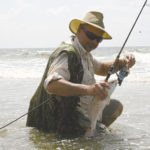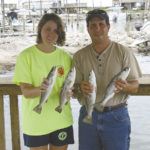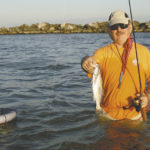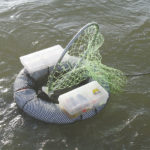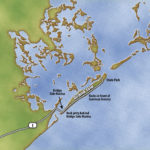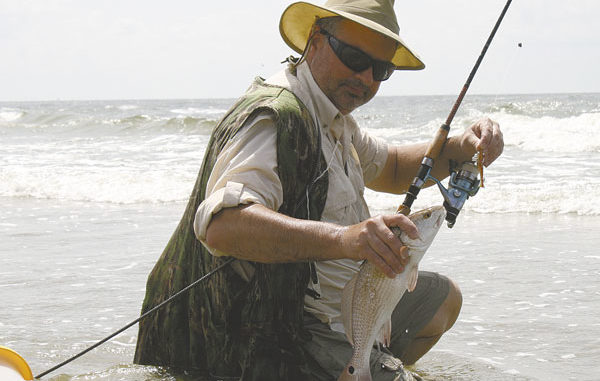
July is month to apply for public-land alligator tags
Speckled trout or redfish, live baits or plastics, rising tide or falling tide. Every month Louisiana Sportsman has several articles discussing the myriad details of saltwater fishing.
Unfortunately, much of the information goes over the head of a North Louisiana boy like me. Saltwater fishing was just not something I was going to try anytime soon. Or at least, that’s what I thought.
Recently, while returning from an unproductive flyfishing trip to Arkansas, I began to ponder other places I might go. Somewhere around Little Rock it struck me.
My best Arkansas trips take place in the fall and winter, and I knew the speckled trout fishing was best on the coast during the spring and summer. It is the same distance from my house to the Gulf as it is to northern Arkansas, so why not learn how to fish for speckled trout so I could enjoy some good fishing all year long?
What follows is my introduction to speck fishing. If you are a veteran saltwater sportsman, you can skip on to the next article. No secret bait, hidden honey hole or new tactic is to be found here. This is for all of my fellow North Louisiana neophytes who are looking to try something new.
In preparing for my quest, I did two things. The first was to start reading LouisianaSportsman.com’s inshore fishing reports every day.
Over a few weeks, I found numerous posts discussing speck fishing at Grand Isle, with a lot of good advice on where to go and what baits to use. Therefore, I decided to make it my destination.
The second thing I did was buy a copy of Todd Masson’s book Specks. It is full of information and has one entire chapter devoted to Grand Isle. According to Masson, the speckled trout can be found along the beach from mid-April to October, with the peak season being July and August.
Next, I picked up an assortment of plastic baits, sinkers, jigheads, hooks, popping corks, and a couple of MirrOlures for topwater fishing. To hold my gear, I also bought a soft tackle box I could sling over my shoulder, and I had a simple pair of sandals to protect my feet while wading.
For bait, the postings on the website recommended both live shrimp and Berkley’s Gulp Shrimp. Since I didn’t want to wrestle with a bucket in the surf, I opted for a container of the 3-inch Gulp Shrimp in natural color, and slipped it into my tackle box.
Arriving at Grand Isle on a mid-week afternoon, I first tried the state park. With a Gulp Shrimp under a cork on my spinning rig, I started casting around the rocks that parallel the beach.
Masson explains in Specks that these rocks were put in place for erosion control and can be found along much of the island’s beaches. They are also good places to fish because they concentrate the trout that otherwise would disperse in deeper water.
Standing in crotch-deep water, I constantly had to flex my legs to stay
balanced as the swells rocked me to and fro. After three hours of fishing,
I was exhausted.
To make matters worse, I didn’t get a single bite. Nada! Nothing! I really didn’t expect to catch much on my first try, but — dang! — that was discouraging.
For the next day, I wanted some early morning topwater action. My research indicated the fish bite best at the crack of dawn and usually shut down soon after sunrise.
Unfortunately, the state park does not open until 7:00 a.m., too late for early morning topwater fishing. Therefore, I followed the advice of some Sportsman reports and tried the rock jetty behind Bridge Side Marina.
Getting up at 5:00 a.m., I drove to a large parking area adjacent to the marina. The eastern sky was just turning pink as I walked over the sand levee and eased into the cool water. Casting my MirrOlure toward the brightening sky, I twitched it twice and a nice trout smacked it. It happened so fast I was caught completely off guard, but quickly recovered and reeled in the 2-pound fish.
As the trout dashed and darted around me in the dark, I realized I had neglected an important item — a landing net. Specks are slippery, and it was with difficulty that I finally managed to unhook him. While trying to loosen the treble hooks without impaling a finger, I made a mental note to put some needlenose pliers in my pocket the next time.
Thrilled with my catch, I made a second cast to the same spot, and another trout viciously attacked the lure. After landing him, the surprise and euphoria gave way to smugness. “How hard can this be?” I thought.
Well, pretty hard, as it turned out. I continued to cast for the next couple of hours, but managed to catch just two more fish.
Following the advice of a couple of fellow fishermen, I headed to the rocks behind the Sureway grocery for my afternoon trip. Locating the grocery was easy, but it was difficult to find a public parking lot with beach access among the businesses and private camps.
I finally found a parking spot about a half mile past the grocery, and managed to land seven trout before dark using the Gulp Shrimp. Things were looking up, and I decided to come back the next morning.
It was barely light enough to see when I entered the water the next day and noticed another fisherman was already out by the rocks. Suddenly, the water exploded between us! All I could see were the fins of a large fish chasing bait.
I froze in place. There I was in knee-deep water, in the dark, and sharks were on a feeding frenzy. The scene from Jaws immediately ran through my mind where Chief Brody solemnly reveals that most shark attacks take place in about 2 feet of water.
Then I noticed the other fisherman was going about his business not paying the commotion any mind. Finally, I saw the familiar role of a porpoise and realized I was not going to get eaten after all.
I made my first cast, and a trout immediately attacked the topwater lure. Then another, and another, and another. Over the next two hours, I landed seventeen nice specks on the MirrOlure, and missed twice that many strikes.
A return trip the next morning yielded seven more trout. I caught all of them by either casting to areas where sea gulls were diving on bait or to places where I could see fish feeding on the surface. It pays to keep a sharp lookout for such activity.
My three-day trip resulted in 42 speckled trout, a handful of hardhead and gafftop catfish, and a nasty needle fish that managed to nip my finger and thumb when I tried to take him off. I was exhausted and my lower back and legs hurt from battling the surf, but I was hooked and planned to return as soon as possible.
Unfortunately, my next trip a few weeks later was pretty much a bust. The trout refused the MirrOlure, Gulp Shrimp and assorted plastic baits that I offered. But I did pick up some useful information from another fisherman.
While near the rock jetty behind Bridge Side Marina, I noticed a couple catching quite a few fish, and decided to seek some advice from them. Steve Notariano Sr., informed me he had been coming to Grand Isle for 20 years, but it was his wife, Ashley’s, first trip.
“I sold my boat, and this is what we’re relegated to,” he said. “I wanted to get her into it.
“I like to use artificials, especially topwater baits. I also change baits a lot to see what they’re biting. I’m an old bass fisherman and am used to changing baits a lot. But if they’re hitting live bait, I’ll use live bait like shrimp or cocahoes. Trout can be finicky.”
I discovered that Steve and Ashley were like me — they enjoyed the experience of surf fishing whether they caught much or not.
“I’ve never done it before, but I enjoyed it,” Ashley said. “It’s a lot of work, especially when you’re used to being in a boat and everything is laid out around you. It’s a challenge, but fun.”
Before parting, Notariano gave up one last bit of advice.
“You usually need a tide,” he said. “A buddy of mine does it more than me, and he likes an incoming tide. If you have moving water and clean water, you’ll usually catch some fish.”
One of Masson’s sources in Specks says surf fishing is best late on an incoming tide because that is when the water will be at its clearest. Fortunately, the Sportsman includes tide tables for Grand Isle each month so you can plan the best time to be fishing.
In addition to the tide, wind can also make a difference. Another expert in Specks points out a light northerly wind can help because it lays down the surf a bit. A southerly wind, on the other hand, can whip up the surf and dirty the water.
After this disappointing trip, I chalked up my initial success to beginner’s luck, and decided I needed some veteran guidance if I was going to unlock the secrets of speckled trout fishing.
Fortunately, Donnie Hayes, a friend of my cousin Clay Scoggin, has more than 40-years experience fishing Grand Isle. The three of us soon met up at Grand Isle Suites so Clay and I could fish a couple of days under Hayes’ watchful eye.
That afternoon, we headed for the rocks near Sureway grocery. While walking out of the room, Donnie glanced at my sandals and asked, “You’re not wearing any socks with those things?”
“No,” I replied suspiciously. “Why?”
“You mean you never had one of those big ol’ crabs grab your toe?” Donnie asked with a smile.
That was all the warning I needed, and I began wearing slip-on wading shoes.
That afternoon, Donnie tossed sparkle beetles on a tandem rig and bounced them off the bottom while Clay used a DOA shrimp under a cork. Together they caught a few small trout and catfish, while I struck out on the Gulp Shrimp.
Wading back to shore after sunset, Donnie kept on casting and caught a nice trout right near the beach in water just over ankle deep.
This was an important reminder of something several people had mentioned to me. There often is a knee-deep trough that runs between the beach and first sand bar, and speckled trout will feed there. Always stop on the beach and make some casts into this shallow feeding area before proceeding to deeper water.
The next day, we probed the rock jetty behind Bridge Side Marina with live shrimp and Gulp Shrimp, and got into some small redfish. I had never caught one before, and enjoyed adding several of them to my list of saltwater trophies.
That night while enjoying cigars on the Grand Isle Suites balcony, I quizzed Donnie on the fundamentals of surf fishing.
Tackle, he said, should be kept simple.
“I use a spinning reel just because I can throw it farther, and I use a 7-foot rod,” he said. “But I see a lot of people catching fish using a regular baitcasting rig. My wife fishes with an old spincast reel, a Zebco 33. Just use a light line so you can throw it a ways.”
I also asked Donnie what bait he would advise the novice to start off with.
“For someone who has never saltwater fished, I’d advise them to use live shrimp,” he said. “Now you might catch 20 catfish on them besides trout, but you’ll catch something. And I would recommend fishing them under a cork because it’s easier, but a Carolina rig is good, too.”
Small minnows known as cocahoes are another popular live bait.
“The best string of fish I’ve ever seen caught down here was by an old man right behind the library using cocaho minnows,” Hayes said. “He sat on the beach and loaded a box, and we didn’t catch a thing wading.”
If you prefer artificial baits, Donnie’s advice is to use sparkle beetles in either chartreuse or root beer color.
“Those are the two I fish on a 1/4-ounce jighead on a tandem rig. Crappie tube jigs can be good too, but the problem with them is that they’re so light you can’t cast them very far.
“Topwater baits can also be good, but you can’t fish them when there are heavy waves. I like the MirrOlures, but I’ve also caught some pretty good fish on bass baits like Crazy Shads and Zara Spooks.”
How does someone who has never been to Grand Isle know where to start fishing?
“Just stop at any of the tackle shops and ask them what they’re biting and where they’re catching them, and they’ll tell you,” Donnie advised. “We used to just drive down the street and look at all the little public parking places. If we didn’t see a number of vehicles in one, we kept going until we did find a crowd.”
Scouting can also be useful in finding areas where the trout feed.
“When the tide is out, you can scout along the beach and see those sand bars that run out from the beach at an angle,” Donnie said. “The last time my wife and I were here we were walking the beach at low tide and could see a place where the water had washed out and a sand bar ran. I came back the next day and caught a lot of fish right there at the end of the sand bar where it dropped off into deeper water.”
If wading is not your thing, you can set up on the beach itself. I frequently chatted with people who fished from lawn chairs both day and night. One older couple, in particular, had a nice assortment of trout and drum caught on chartreuse sparkle beetles.
One last piece of advice Donnie had for beginners is to invest in a floating fish ring for about $20. Found at the larger sporting goods stores, fish rings are fish baskets attached to circular Styrofoam rings. It can be a chore trying to put a slippery speck on a fish string, but with the fish ring, you can just drop him in the basket.
Donnie had even tweaked his fish ring with some handy accessories.
“I added a rod holder on mine so when I’m taking a fish off or changing baits I can use both hands,” he said. “And when I’m fishing I can stick my net down in there. I also have a little tackle box that I have zip tied to it and can carry four or five baits in it.”
Heading home across the Caminada Pass bridge the next day, I mentally calculated when I could return to Grand Isle. Although I was still not an experienced speck fisherman, I was no longer the helpless rookie. Learning to fish the surf had been surprisingly easy and is something everyone living in the Piney Hills should try.
